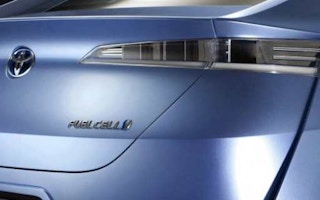Hydrogen fuel cells have long been seen as a potentially perfect way to power a car: They generate electricity and emit only water vapor. While a few cars have been tested, Toyota Motor Corp. is about ready to roll.
The automaker that defied skeptics in the ’90s with its Prius gasoline-electric hybrid cars is looking for a fuel-cell sequel. At the Tokyo Motor Show in November, it plans to show a hydrogen-powered sedan that would be sold as a 2015 model. It could be available in U.S. dealerships as soon next year for a price comparable to a mid-size BMW or Tesla Model S.
The allure of hydrogen, the most abundant element in the universe, as a clean gasoline replacement led carmakers a decade ago — notably the former General Motors Corp. — to predict millions of fuel cell autos would be on the road by now. While a mass-market for hydrogen cars may be a decade or more away, the enticement is undiminished.
“We’re now in the ‘trough of disillusionment’ for fuel-cell vehicles,” said John German, program director with the International Council on Clean Transportation environmental policy group, citing a phase of Gartner Research’s “Hype Cycle” that charts commercial viability of new technologies.
“This is a genuinely better vehicle” over the long term than gasoline-burning or battery-only autos, said German, a contributor to National Academy of Sciences studies.
‘Fool cells’
Environmental rules in the U.S., Europe and Japan encourage automakers to sell vehicles that don’t emit climate-warming gases. That has aided hybrid sales, led to lighter cars and smaller engines and convinced Tesla Motors Inc. and Nissan Motor Co. to push high-volume sales of battery cars.
Battery-electric vehicles such as Tesla’s Model S and Nissan’s Leaf hatchback share many technologies with fuel-cell cars. They use similar electric motors to power the wheels and brakes that capture power when stopping, as well as software and related electronics.
The difference is the energy source. Battery cars store electricity in large lithium-ion packs — Tesla’s weigh 1,000 pounds (454 kilograms). Fuel cells generate it in an electro-chemical reaction of hydrogen and air.
In a fuel cell, hydrogen gas passes through a stack of plastic membranes and metal plates — like syrup soaking a tower of platinum-dusted pancakes — to produce electricity.
Because of the precious metals needed, fuel-cell stacks remain expensive, as do high-pressure hydrogen tanks. Prototypes have cost $1 million to make.
Other challenges
Challenges lurk beyond the car itself. Most commercial hydrogen is made from natural gas, which uses a lot of power and emits carbon. It takes energy to compress the gas for storage at fuel stations, of which there are few, clustered mainly in Southern California.
Tesla Chief Executive Officer Elon Musk said hydrogen’s shortcomings make it a dead-end for vehicles.
“Fuel cells should be renamed ‘fool cells,’ they are so stupid,” he said in an interview last month. “You could take best case of a fuel cell, theoretically the best case, and it does not compete with lithium-ion cells today. And lithium-ion cells are far from their optimum.”
Nevertheless, Toyota sees potential to top its Prius success with a hydrogen fuel cell sedan.
In 1997, Toyota touted the first mass-produced hybrid as having twice the fuel economy and half the carbon exhaust of a conventional car. Some dismissed it as a money-losing science project, yet the gamble paid off. Toyota has since sold almost 4 million Prius models, making it the most successful alternative powertrain vehicle line.
‘Wildly inflated’
Soon after that debut, Toyota and competitors promoted hydrogen as even more promising. Market-readiness estimates in the early 2000s were “wildly inflated,” said German, who was then a Honda Motor Co. (7267) engineer. Larry Burns, who ran GM’s R&D then, had predicted that 80 million to 90 million fuel-cell vehicles would be sold in the 2010 decade.
Perhaps “hundreds” of leased and prototype hydrogen autos and buses operate on California’s roads, according to estimates by the California Fuel Cell Partnership, the primary evaluation program for the technology. They include versions of Toyota’s Highlander and Hyundai Motor’s Santa Fe mid-size sport-utility vehicles; Honda’s leased FCX Clarity, an Accord-sized sedan; and Daimler’s leased Mercedes-Benz F-Cell wagon.
Hyundai, Honda and Mercedes are also planning increased output of 2015 models.
‘Price competitive’
Toyota declined to forecast sales or production volumes for its new model.
Toyota had said the model would be a Lexus with a price about $50,000. It’s now non-committal on the brand, and the car will cost in the neighborhood of $50,000, “depending on how big your neighborhood is,” Chris Hostetter, U.S. group vice president for advanced product development, told reporters last month.
It will be “price competitive” with Tesla’s $69,900 Model S, he said, and go about 300 miles (483 kilometers) per fueling.
And who’s behind this push? The original chief engineer of the Prius, now-Chairman Takeshi Uchiyamada.








